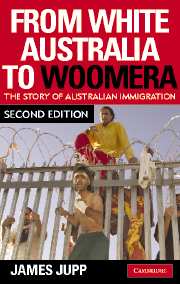Book contents
- Frontmatter
- Contents
- Acronyms and abbreviations
- Introduction
- Chapter 1 Creating an immigrant society, 1788–1972
- Chapter 2 From assimilation to a multicultural society, 1972–2006
- Chapter 3 The Fraser, Hawke and Keating governments, 1975–1996
- Chapter 4 Policy instruments and institutions
- Chapter 5 Multicultural policy
- Chapter 6 The attack on multiculturalism
- Chapter 7 The impact of One Nation
- Chapter 8 Economic rationalism
- Chapter 9 Sustainability and population policy
- Chapter 10 Refugees and asylum seekers
- Chapter 11 Immigration in a global world
- Appendix I Chronology: 1972–2007
- Appendix II Ministers for immigration, departmental secretaries and gross annual settler intake, 1973–2006
- References
- Index
Chapter 4 - Policy instruments and institutions
Published online by Cambridge University Press: 03 May 2010
- Frontmatter
- Contents
- Acronyms and abbreviations
- Introduction
- Chapter 1 Creating an immigrant society, 1788–1972
- Chapter 2 From assimilation to a multicultural society, 1972–2006
- Chapter 3 The Fraser, Hawke and Keating governments, 1975–1996
- Chapter 4 Policy instruments and institutions
- Chapter 5 Multicultural policy
- Chapter 6 The attack on multiculturalism
- Chapter 7 The impact of One Nation
- Chapter 8 Economic rationalism
- Chapter 9 Sustainability and population policy
- Chapter 10 Refugees and asylum seekers
- Chapter 11 Immigration in a global world
- Appendix I Chronology: 1972–2007
- Appendix II Ministers for immigration, departmental secretaries and gross annual settler intake, 1973–2006
- References
- Index
Summary
The Immigration Department
Australia is unusual in having a distinct Immigration Department, which is normally represented in the Cabinet. In Britain, immigration is only one function of the Home Office, which is centrally concerned with policing and law and order. Similarly in the United States, the Immigration and Naturalization Service is part of the attorney general's department. In Canada, immigration was previously the concern of the Department of Labour, while multiculturalism has been administered through a quite distinct agency. In many European states immigration is controlled by agencies also responsible for police, crime and public order.
The existence of a specialist department for all but eighteen months (1975–76) since 1945 emphasises the bureaucratic planning role of the state in building and selecting population. Distinct immigration statistics are developed by the department as an adjunct to its own planning. The Australian Bureau of Statistics duplicates this function to some extent. This has meant that Australia has some of the most detailed and meticulous migration statistics in the world. Its research capacity has also been considerable, especially between 1979 and 1986 through the Australian Institute of Multicultural Affairs and from 1989 to 1996 when the Bureau of Immigration, Multicultural and Population Research was producing a flow of information and analysis. This kept Australia in the forefront of immigration studies, given the lack of interest by most academic social scientists. While this research capacity has been substantially reduced, much analysis of immigration issues is still produced within the bureaucracy rather than by academics.
- Type
- Chapter
- Information
- From White Australia to WoomeraThe Story of Australian Immigration, pp. 57 - 79Publisher: Cambridge University PressPrint publication year: 2007



